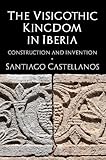The Visigothic Kingdom in Iberia : Construction and Invention / Santiago Castellanos.
Material type: TextPublisher: Philadelphia : University of Pennsylvania Press, [2020]Copyright date: ©2021Description: 1 online resource (288 p.) : 8 illusContent type:
TextPublisher: Philadelphia : University of Pennsylvania Press, [2020]Copyright date: ©2021Description: 1 online resource (288 p.) : 8 illusContent type: - 9780812297423
- 946/.01 23/eng
- DP96
- online - DeGruyter
| Item type | Current library | Call number | URL | Status | Notes | Barcode | |
|---|---|---|---|---|---|---|---|
 eBook
eBook
|
Biblioteca "Angelicum" Pont. Univ. S.Tommaso d'Aquino Nuvola online | online - DeGruyter (Browse shelf(Opens below)) | Online access | Not for loan (Accesso limitato) | Accesso per gli utenti autorizzati / Access for authorized users | (dgr)9780812297423 |
Browsing Biblioteca "Angelicum" Pont. Univ. S.Tommaso d'Aquino shelves, Shelving location: Nuvola online Close shelf browser (Hides shelf browser)

|

|

|

|

|

|

|
||
| online - DeGruyter In Good Faith : Arabic Translation and Translators in Early Modern Spain / | online - DeGruyter "Ethel's Love-Life" and Other Writings / | online - DeGruyter Subscription Theater : Democracy and Drama in Britain and Ireland, 1880-1939 / | online - DeGruyter The Visigothic Kingdom in Iberia : Construction and Invention / | online - DeGruyter Perspectives on Fair Housing / | online - DeGruyter Occupied America : British Military Rule and the Experience of Revolution / | online - DeGruyter Meter and Modernity in English Verse, 1350-1650 / |
Frontmatter -- Contents -- Preface -- Chapter 1. The Collapse of the Roman Empire in Hispania: Between the Texts and the Archaeological Revolution -- Chapter 2. Political Overview: The Beginnings of the Gothic Kingdom in Iberia -- Chapter 3. Structures of Power: Magnates and Dependents -- Chapter 4. Negotiating and Imposing: Kings and Local Worlds -- Chapter 5. Inventing a Kingdom: Projecting Messages -- Conclusion -- Chronology -- Abbreviations -- Notes -- Bibliography -- Index -- Acknowledgments
restricted access online access with authorization star
http://purl.org/coar/access_right/c_16ec
The structures of the late ancient Visigothic kingdom of Iberia were rooted in those of Roman Hispania, Santiago Castellanos argues, but Catholic bishops subsequently produced a narrative of process and power from the episcopal point of view that became the official record and primary documentation for all later historians. The delineation of these two discrete projects—of construction and invention—form the core of The Visigothic Kingdom in Iberia.Castellanos reads documents of the period that are little known to many Anglophone scholars, including records of church councils, sermons, and letters, and utilizes archaeological findings to determine how the political system of elites related to local communities, and how the documentation they created promoted an ideological agenda. Looking particularly at the archaeological record, he finds that rural communities in the region were complex worlds unto themselves, with clear internal social stratification little recognized by the literate elites.
Mode of access: Internet via World Wide Web.
In English.
Description based on online resource; title from PDF title page (publisher's Web site, viewed 01. Dez 2022)


